Table of Contents
Key Takeaways
- B-Vitamins and multivitamins are crucial for brain health and neurotransmitter synthesis.
- Acetylcholine’s role in ADHD can be supported with nootropics like ALCAR and CDP-Choline.
- Nootropics like Ashwagandha and Bacopa Monnieri help repair damaged neuroreceptors in ADHD.
- Noopept enhances cognition, memory, and provides neuroprotection.
- Combining specific nootropics with essential vitamins can optimize brain function for managing ADHD symptoms.
Depending on the severity of your ADHD symptoms, you may be able to use nootropics as an alternative to prescription stimulants like Adderall, Ritalin, Vyvanse and their variations.
I experimented for a year by using nootropics in place of the 20 mg of Ritalin I had been using 3-times a day for several years. And for the most part, I was successful in taming my Adult ADD symptoms.
Adult ADD Nootropic Stack
The ADD/ADHD stack I use includes:
- Mind Lab Pro
- Performance Lab® Energy – twice per day
- CDP-Choline – twice per day
- ALCAR – 750 mg 1-time per day
- L-Tyrosine – 500 mg 3-times per day
- Sulbutiamine – 400 mg twice per day
- Aniracetam – 750 mg twice per day
- Vinpocetine – 10 mg 3-times per day
- Performance Lab® Omega-3 – 3 GelCaps per day
- 1 tablespoon unrefined Coconut Oil or MCT Oil– 3-times per day
- Performance Lab® NutriGenesis Multi – 4 caps per day
During my one-year stimulant holiday, the ingredients in Mind Lab Pro along with L-Tyrosine, CDP-Choline, and ALCAR (included in Performance Lab Energy) kept my dopamine, norepinephrine, and acetylcholine levels high enough to maintain focus, motivation and improve my memory. Vinpocetine kept my brain blood flow at optimal levels. And Aniracetam and Sulbutiamine improved my mood.
But after a year I decided to go back to using 20 mg of Ritalin twice per day. Because my workload had me writing 10 hours per day. And maintaining working relationships with 2 or 3 clients at once.
By adding Ritalin back to my stack I was able to reduce the time it would take to complete a project from 3 days to 1 ½ days. Proof to me that my overall brain health couldn’t make it with nootropics alone.
The beauty of continuing to use L-Tyrosine, CDP-Choline, and ALCAR even after I started using Ritalin again was that I avoided the stimulant “crash” that is so common late afternoon when using stimulants. And I was able to reduce the original 20 mg Ritalin 3-times per day down to only twice per day.
And I have not experienced building up tolerance to Ritalin that is so common when using stimulants to treat ADD or ADHD.
Your situation may be different, or ADHD symptoms not as severe. Only you can decide if nootropics can replace ADHD meds. The stack I describe on this page is designed to be used with or without stimulant meds.
Whether you use this stack with meds or without, you’ll need to discover for yourself what dosages of each nootropic are ideal for you. Because the amounts that work for me may not work as well for you. You may need less NALT and/or ALCAR.
Experimenting is the key to success with nootropics. And knowing as much as you can about what’s going on in your brain that needs to be fixed. But after many years of recommending this ADHD nootropic stack to people just like us around the world, we know this works.
The pre-made nootropic stacks mentioned in this post include:
Prescription “Smart Drugs” vs. Nootropics for ADHD
This post is in response to many emails and questions I’ve been getting about how to treat Attention Deficit/Hyperactivity Disorder (ADHD) or Attention Deficit Disorder (ADD) with nootropics.
So if you are dealing with ADHD, hopefully this post will help. Especially if you are using stimulants like Ritalin, Adderall, Vyvanse, Focalin, or any of the other stimulant prescribed for ADD/ADHD. Or you are trying to deal with ADHD naturally by avoiding prescription stimulants.
This information can also help if you are a student or executive who uses prescription “smart drugs” like Adderall or Modafinil to boost productivity.
Here we’ll dig into the causes of ADHD or ADD in your brain. Symptoms associated with ADHD. And what you can do using nootropics, or nootropics stacked with stimulants to correct ADHD symptoms.
I’ll also include ways to potentiate the effectiveness of prescription stimulants with nootropics so they work better.
If you’ve never ‘officially’ been diagnosed with ADHD, but some of this resonates with you, you could be ADHD or ADD. And this may point you to some answers.
I’ve been ADD all my life. (ADD is ADHD without the hyperactivity). But it wasn’t until about 16 years ago, that a very wise psychiatrist identified what was going on. And why I had been struggling with focus and other problems with behavior. That no amount of self-help books on focus and management could ever correct.
Ritalin turned the lights on for me. And completely changed my life for the better. This was the seed that sprouted my interest in neuroscience and nootropics. And ultimately launching Nootropics Expert®
What is ADHD & ADD?
Attention Deficit/Hyperactivity Disorder (ADHD) or Attention Deficit Disorder (ADD) are associated with attention and executive function in your brain.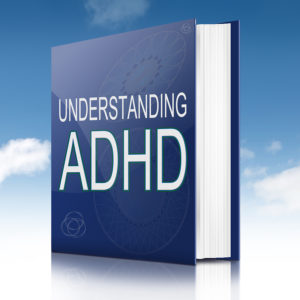
Your prefrontal cortex directs behavior, thought and feeling which are all associated with working memory. This fundamental cognitive function is what most “healthy” people take for granted, are what make up executive function.
This executive function and working memory give you the ability to:
- Regulate your attention
- Inhibit inappropriate behavior and thought
- Monitor your actions
- Plan and organize your future
If you can’t focus on the task at hand, blurt things out at inappropriate times, have little control over your emotions or actions, and can’t seem to stick to that careful set of goals you wrote down, you may be ADHD.
The Role of Norepinephrine and Dopamine in ADHD
Norepinephrine and dopamine are the primary neurotransmitters involved in ADHD because they play an essential role in attention and thinking.[i]
The “inattentive” type of ADHD is related to issues with the norepinephrine, and the “hyperactive and impulsive” type of ADHD is linked to dopamine dysfunction.
These two neurotransmitters work in concert to maintain alertness, increase focus, sustain thought, effort, and motivation. The only difference between the two is the presence of a hydroxyl group. And dopamine is the precursor to norepinephrine synthesis in your brain.[ii]
Much of what we read about ADHD focuses on dopamine’s function in your brain. But norepinephrine (NE) plays a critical role in activating your reaction to events. And how you respond to the event.[iii] NE is essential for collecting information coming in through your senses. And then modulating your brain’s response.
Any disruption in this NE system can result in ADHD, Post Traumatic Stress Disorder (PTSD), sleep disorders and more.[iv]
For example, NE working with postsynaptic α2-adrenoceptors (α2-AR) in your brain play an essential role in helping you focus and eliminate distractions when you’re paying attention to something.[v]
This is just one example of what goes wrong with ADHD brain function. My point in bringing this all up is not to overwhelm you with neuroscience.
But to make clear that simply suggesting too much or too little of a single neurotransmitter like dopamine cannot explain the complexity of ADHD.
So using a nootropic like L-Tyrosine to amp up dopamine in your brain is often not enough to take care of ADHD symptoms. Or using Adderall with someone who has a problem with alpha2-receptor binding with norepinephrine may not get much benefit.
This is the reason that experimenting with various stimulants and/or nootropics is often the only way to find a long-term solution to keeping ADHD under control. And why some respond better to a drug like Ritalin and not as well to Adderall. Or vice versa.[vi]
And recent research shows serotonin and acetylcholine are involved too. Mostly the “hyperactivity” part of ADHD which includes movement, inattention, and impulsivity.[vii]
Smart Drugs Used to Treat ADHD Symptoms
If you are truly and clinically ADHD or ADD, it is unlikely that optimizing your diet, getting plenty of sleep, using nootropics, and exercising regularly will get the symptoms of ADHD under control.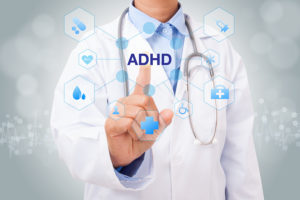
The most severe forms of ADHD often benefit from using prescription medication. Otherwise known as “smart drugs” in some circles, these meds are typically amphetamines or methylphenidate.
The amphetamine-class of ADHD prescription drugs includes Adderall (75% dextroamphetamine salts and 25% levoamphetamine salts), Dextroamphetamine, and Vyvanse (Lisdexamfetamine).
The methylphenidate-class of ADHD medications includes methylphenidate (Ritalin) and its variants like Concerta, and Focalin.
Adderall and Ritalin both work with dopamine and norepinephrine in your brain. But through different mechanisms of action.
Ritalin is a pure uptake inhibitor of dopamine and norepinephrine without any other presynaptic activity.[viii] Adderall on the other hand, has additional presynaptic activity, releasing dopamine and norepinephrine from presynaptic neurons.
The idea for the last 60 years or so, has been if we could boost dopamine and norepinephrine in the brain, ADHD symptoms would go away. As long as we’re taking the medication.
Why Prescription Attention Deficit Hyperactivity Disorder Meds Often Don’t Work
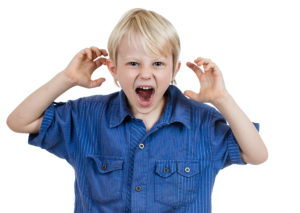 In an ideal world, taking one pill 2 or 3 times a day to treat ADHD would put your life back on track. And help you function like a ‘normal’ person.
In an ideal world, taking one pill 2 or 3 times a day to treat ADHD would put your life back on track. And help you function like a ‘normal’ person.
But real-world results often don’t work out as well as theory. For several reasons. For example, what if there’s not enough dopamine or norepinephrine in your brain in the first place? Then stimulants will not work as well as planned because they haven’t the neurotransmitters in place to work with.
You could also have problems with not enough or damaged neuroreceptors. Natural aging processes can slow blood flow or inhibit the production of neurotransmitters. A lack of acetylcholine could prevent your neurotransmitters from doing what they were designed to do.
This is where nootropics can help save the day in treating the symptoms of ADHD.
Optimizing Dopamine & Norepinephrine
 One of main culprits contributing to ADHD symptoms is a lack of dopamine (DA) and norepinephrine (NE) in your brain. Or your brain is not using the available DA and NE effectively.
One of main culprits contributing to ADHD symptoms is a lack of dopamine (DA) and norepinephrine (NE) in your brain. Or your brain is not using the available DA and NE effectively.
Stimulants like Adderall and Ritalin work to boost levels and use of these two critical neurotransmitters.
Production of dopamine and norepinephrine in your body and brain follows this metabolic pathway:
Phenylalanine → Tyrosine → L-DOPA → Dopamine → Norepinephrine
Dopamine is converted to norepinephrine by the enzyme dopamine β-monooxygenase, with O2 and ascorbic acid (Vitamin C) as cofactors.
Norepinephrine can be further converted into epinephrine by the enzyme phenylethanolamine N-methyltransferase with SAM-e as cofactor.
Nootropics to boost dopamine and norepinephrine include:
- L-Tyrosine – L-Tyrosine is the precursor to the synthesis of dopamine in your brain. L-Tyrosine enhances working memory, executive function, creative flow states, reduces stress, improves mood and is anti-anxiety.Suggested dosage of L-Tyrosine or NALT for ADHD is 350- 500 mg twice per day. I successfully stack 500 mg of NALT or L-Tyrosine 3-times per day. Once each time I dose with Ritalin, and a last dose mid-afternoon to prevent a stimulant crash later in the day.
- Mucuna Pruriens (L-Dopa) – Mucuna works as an antioxidant and heavy metal chelator, improves memory & cognition, reduces depression and boosts libido.L-Dopa is also the direct precursor to dopamine. Suggested dosage of Mucuna Pruriens is 250 – 500 mg per day. But if you’re just starting out with nootropics, I highly recommend using L-Tyrosine or NALT instead of Mucuna Pruriens. Because Mucuna can be more difficult to dose since it directly stimulates the production of dopamine. L-Tyrosine and NALT are more ‘forgiving’ when it comes to dosage.
- N-Acetyl L-Cysteine (NAC) – NAC is an amino acid that regulates the amount of glutamate and dopamine in your brain.NAC can be used to address the symptoms of ADHD. And may even help eliminate some of the negative side effects associated with prescription ADHD stimulants. Suggested dosage of NAC is 600 mg 3-times per day.
- Phosphatidylserine (PS) – PS can help improve alertness, attention, cognition, memory, recall and mood, and lower anxiety. All issues associated with ADHD.Phosphatidylserine is a phospholipid component of the membrane encasing every one of your brain cells. PS helps maintain the fluidity and permeability of brain cells. Improving the flow of dopamine and acetylcholine. Suggested dosage of PS is 100 mg 3-times per day.
- Pine Bark Extract – Pine Bark extract helps prevent decreases in dopamine and norepinephrine. And the glutathione (GSH) and GSH-disulphide reductase (GSSG-R) ratio. Neurotransmitter problems which contribute to hyperactivity in ADHD.Pine Bark extract also helps boost blood flow in the brain by increasing nitric oxide which helps dilate blood vessels. And it helps reduce oxidative stress, membrane damage, DNA damage, inflammation, and glycation.I’ve found one of the most potent forms of Pine Bark extract comes in both Mind Lab Pro® and Performance Lab® Mind.
A word of caution here in boosting the catecholamines dopamine and norepinephrine. Too much of either is not a good thing. In fact, excess levels of either will throw your neurotransmitter levels out of balance. And can cause anxiety, insomnia and panic attacks.
Taming Hyperactivity with Nootropic Supplements
The “H” in ADHD stands for hyperactivity. Boosting levels of dopamine and norepinephrine can help balance out hyperactivity. And help calm and focus your mind. But often simply boosting or balancing these neurotransmitters is not enough.
Recent studies show that serotonin and dopamine interaction also play a role in ADHD.[ix] Serotonin is involved in the uptake, synthesis and breakdown of dopamine in your brain. Problems with serotonin seem to contribute to behavior and impulse control.
Much more research needs to be done in this area of ADHD. But we can help control and balance serotonin with nootropics.
- 5-HTP – This amino acid is synthesized from the amino acid tryptophan. And 5-HTP is the immediate precursor to serotonin in your brain.5-HTP can help relieve anxiety and depression, fibromyalgia, insomnia, migraines and likely the hyperactivity, depression and anxiety associated with ADHD. Suggested dosage of 5-HTP is 50 mg up to 3-times per day. Please see my dosage notes and warnings before you try supplementing with 5-HTP.
- Ginseng – Ginseng helps calm anxiety, and boost attention, concentration and memory. Ginseng provides neuro-protective effects on the dopaminergic-pathway which can help with ADHD. And ginseng is a serotonin and norepinephrine reuptake inhibitor (SNRI).Suggested dosage of Ginseng is 100 – 400 mg per day.
- L-Theanine – L-Theanine commonly found in green tea helps boost alpha and theta brain waves, is anti-anxiety, boosts cognition and memory and reduces insomnia.L-Theanine also helps boost GABA, serotonin and dopamine levels in your brain. Suggested dosage of L-Theanine is 150 mg 2 – 3-times per day.
- Rhodiola Rosea – Rhodiola Rosea helps improve alertness, energy, memory and mood, is anti-anxiety and antidepressant, reduces fatigue and boosts memory and concentration.Rhodiola influences serotonin and norepinephrine levels in your brain. Suggested dosage of Rhodiola Rosea extract is 150 – 200 mg per day.
- Saffron – Saffron acts as a dopamine and norepinephrine reuptake inhibitor. Similar to how Ritalin works. A randomized double-blind study was conducted with 54 children 6-17 years old who were given 20 – 30 mg methylphenidate or 20 – 30 mg Saffron per day for 6 weeks. At the end of the study researchers concluded, “Short-term therapy with a saffron capsule showed the same efficacy compared with methylphenidate.”Suggested dosage of Saffron is 30 mg per day.
- Vitamin B6 (Pyridoxine) – Vitamin B6 helps your brain make serotonin, norepinephrine and melatonin. Suggested dosage of B6 is up to 100 mg per day.
- Vitamin B9 (Folate) – Folate (NOT folic acid) as a nootropic helps your brain make dopamine, epinephrine, norepinephrine and serotonin. Suggested dosage of Folate is 400 mcg per day.
- Vitamin B12 (methylcobalamin) – is a cofactor in the synthesis of neurotransmitters acetylcholine, dopamine, GABA, norepinephrine, and serotonin. Suggest dosage of B12 is 100 mcg per day.
B-Vitamins are Critical in Controlling ADHD
Take note that several of the B-Vitamin group are involved in the production of the neurotransmitters involved in ADHD. I recommend adding a good B-Vitamin Complex that include methylfolate (not folic acid) and methylcobalamin (not cyanocobalamin) to your stack. Both in a pure nootropic stack as well as when using any of the ADHD prescription stimulants.
But it’s not only the B-Vitamins that are required for a healthy, fully functioning brain. We also need each of the 13 vitamins and 13 minerals needed for everything from blood flow, neurotransmitter synthesis and release, brain signaling, and neuroprotection.
I’ve found the easiest way to make sure my ADD brain gets all the vitamins and minerals it needs every day is to also use a multivitamin/mineral supplement.
The best I’ve found so far is the multivitamin called Performance Lab® NutriGenesis Multi. It’s better than the “raw-food” multi I was using for years. And makes a difference I can actually feel.
But please note that this multi is in addition to a B-Vitamin Complex because the ADHD brain needs more of these critical nutrients than what is normally in any good multivitamin.
The Role of Acetylcholine in ADHD
Researchers at Vanderbilt University Medical Center discovered that there are three types of ADHD.
We’ve already covered the “inattentive” type that is related to issues with the norepinephrine transporter gene. And the link to the dopamine transporter gene in the “hyperactive and impulsive” type.
But the research team now report that a variation in the choline transporter gene is associated with a “combined” type of ADHD. Symptoms include both inattention and hyperactivity/impulsivity.
Choline is required to synthesize acetylcholine (ACh) which is needed for memory, motor-control, focus, learning, concentration, and cognition.
If you have the “combined” type of ADHD it’s likely due to a mutation in this choline transporter gene variation.
Nootropics to boost acetylcholine include:
- ALCAR (Acetyl-L-Carnitine) – ALCAR donates a methyl group in the presence of Coenzyme-A for the synthesis of acetylcholine. And it’s also a shuttle transport for fatty acids through brain cell membranes. It shuttles fatty acids into mitochondria for ATP synthesis, and shuttles toxic byproducts out.
Research from the Linus Pauling Institute shows ALCAR will restore mitochondrial function, replenish age-related changes to mitochondrial structure, and helps replenish acetylcholine levels to your brain and body.
And other studies show that ALCAR stimulates nerve growth factor. Helping support survival and growth of neurons. Which is particularly important for the ADHD brain and especially when using prescription stimulants that may be tough on neurons.
- Alpha Lipoic Acid (R-LA) – Alpha Lipoic Acid increases acetylcholine production by activation of choline acetyltransferase and increases glucose uptake. This process supplies more Acetyl-CoA for the production of acetylcholine.
Alpha Lipoic Acid enhances insulin-stimulated glucose transport and metabolism for better brain cell performance. And R-Lipoic Acid provides strong antioxidant support because it helps regenerate and recycle existing antioxidants in your brain including Vitamins C & E, glutathione, and CoQ10.
I’ve since switched the ALCAR supplement in my ADD stack to Performance Lab® Energy because this pre-formulated energy stack contains my preferred dose of ALCAR. But note that I also take another 500 mg of ALCAR with L-Tyrosine late afternoon to prevent a stimulant crash.
Performance Lab® Energy also contains Alpha Lipoic Acid and ALCAR which helps my ADD brain produce acetylcholine.
- CDP-Choline (Citicoline) – Citicoline helps synthesize phosphatidylcholine (PC), a major phospholipid found in brain cell membranes. And provides choline for the synthesis of acetylcholine while providing antioxidant activity.
The CDP-Choline (Citicoline) in my ADD stack is supplied by Mind Lab Pro® which is the base of my nootropic stack.
But a suitable alternative to MLP is Performance Lab® Mind which contains the branded form of citicoline called Cognizin®.
Performance Lab® Mind and Mind Lab Pro® also contain L-Tyrosine, Phosphatidylserine (PS), and Maritime Pine Bark extract.
Repairing Neuroreceptors Needed to Control ADHD
One of the issues with neurotransmitters and ADHD are damaged or non-existent receptors. Dopamine, norepinephrine and serotonin have less receptors to bind to for cognition and mood control.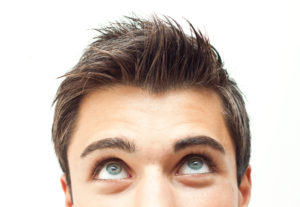
Once again, nootropics come to the rescue in helping control ADHD. You can add one of these nootropics to your stack to help boost neuron and receptor health.
- Ashwagandha – This adaptogen, Ashwagandha helps reduce anxiety and depression. And helps reconstruct axons, dendrites and synapses involved in neurotransmitter signaling in your brain.Suggested dosage of Ashwagandha extract is 250 – 500 mg per day.
- Bacopa Monnieri – Bacopa helps boost memory and cognition, improves mood, and reduces stress. This adaptogen affects brain levels of acetylcholine needed for neurotransmitter signaling.And the two active components of Bacopa Monnieri called bacosides A and B not only improves signaling of electrical impulses between neurons in your brain. Bacosides also help rebuild damaged neurons. Suggested dosage of Bacopa is up to 450 mg per day.
- Lion’s Mane – Lion’s Mane Mushroom is known for stimulating Nerve Growth Factor, improving cognition and memory, and relieving depression.Lion’s Mane stimulates the repair and creation of neurons in your brain. Neurons needed for dopamine and norepinephrine to control ADHD. Suggested dosage of Lion’s Mane Mushroom starts at 500 mg per day. Note: that there’s an effective 500 mg dose of Lion’s Mane full-spectrum fruiting body in each dose of Mind Lab Pro®
- Noopept – Noopept helps boost cognition, memory, learning, perception, logical thinking and mood. Noopept increases Nerve Growth Factor, and Brain-Derived Neurotrophic Factor (BDNF) critical for neuroplasticity and Long-Term Potentiation critical for long-term memory.Noopept also prevents the release of excess glutamate in your brain. Providing potent neuroprotection for neurons and reducing damage. Suggested dosage of Noopept is 10 – 30 mg per day.
Please note that I haven’t linked through to supporting clinical studies for each of the nootropics I listed above. But you can click through to my full review of each nootropic for extensive research supporting each supplement.
Nootropics for Kids
ADHD and ADD is most often diagnosed in children. The latest statistics (2011) from the CDC in the USA shows about 11% of children 4 – 17 years of age (6.4 million) have been diagnosed ADHD.[x] And that’s just for the USA.
Although ADHD is usually first diagnosed in children, it often lasts into adulthood. I sometime wonder how my life would have been different if I had been declared ADD when I was a kid.
But it wasn’t until the late 1960’s that the American Psychiatric Association formally recognized ADHD as a mental health disorder. I wasn’t declared Adult ADD until much later.
The thing is many parents are wary about putting their children on powerful, prescription ADHD meds. Kids’ brains continue to develop until your early 20’s. So is it a problem messing with brain chemistry at such a young age? Only time will tell and if the benefits outweigh any potential risk.
Hence the reason why parents are looking for ‘natural’ alternatives like nootropics to treat ADHD in children. But are nootropic supplements any safer than prescription stimulants?
Common sense tells me that using L-Tyrosine could be safer than Ritalin for boosting dopamine. And Rhodiola Rosea could be safer than stimulants or antidepressants for taming hyperactivity.
But many children with ADHD, natural supplements may not be enough. I’m not a doctor, and don’t even play one on TV. I’m an ordinary biohacker who has learned as much as I can to help myself. And fix my own cognitive performance issues. Including Adult ADD.
So I highly recommend you find and work with an open-minded psychiatrist with your child. You may be pleasantly surprised to find you may be able to reduce or eliminate prescription ADHD meds altogether to enhance cognitive functions. And maybe not. But the long-term health of your child could be worth the time investment to find out.
In Summary
I’ve been wanting to write this post since I started Nootropics Expert®. If you are ADHD or ADD, I hope you found this useful. And I’d appreciate your feedback, and share your experience with treating ADHD with nootropics in the comments section of this post below.
Please share this post with anyone you think would benefit. Including discussions about nootropics for ADHD on reddit or Longecity.
One final note. Neurotransmitter balance is key to taming ADHD. I strongly caution you to take it slow if you’re just starting out with nootropics. Carefully read each of the extended articles in the List of Nootropics you are considering trying.
You need to be careful about side effects, prescription drug interactions, dosages and how your body reacts to each supplement to ensure healthy brain function.
But I’m confident that with careful planning and a long-term commitment, your cognitive enhancement will be just as successful as I have been in living and thriving with my Adult ADD.


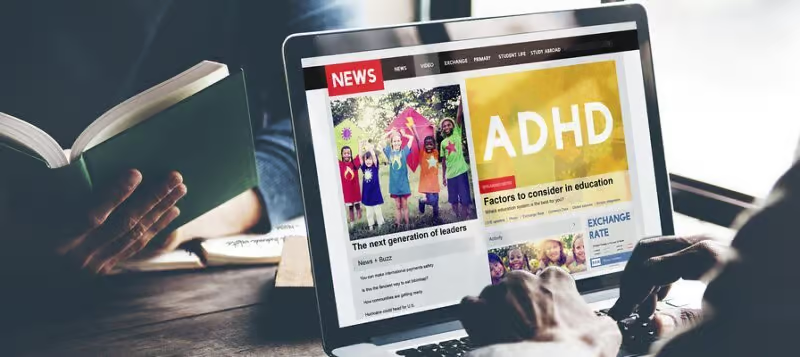

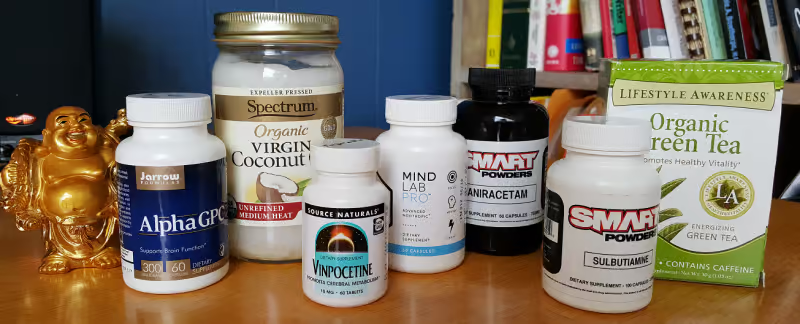



Join The Discussion - 844 comments
Benyamin
October 21, 2020
Hello David;
What type of Ritalin do you use? XR or XL.
have you ever used Adderal with this stack?
I am using the stack of ADHD with modafinil 100mg to 200mg. and added Wel Butrin for few days as the SAD is getting hard here in England.
David Tomen
October 21, 2020
Benyamin, I use instant release Ritalin. I’ve tried Adderall in the past but it didn’t work for me. But this ADHD stack supports any type of stimulant medication.
Elizabeth Bird
October 17, 2020
Hi David, Question for you my eldest son 23 has not been diagnosed with ADHD directly but has all the traits. Mood Swings, inattentive, impulsive, and very cold. The only problem is he is on immune suppressive tablets for a liver transplant 17 years ago. Could you recommend a stack to help him please.
David Tomen
October 17, 2020
Elizabeth, the stack I describe in the above post is made for ADHD. The basics of the stack (refer to the list above) include: L-Tyrosine, Alpha GPC, ALCAR, DHA, and a B-Complex. But you’ll need to check with his doctor to verify that each of these supplements are OK with immune suppression drugs.
Benyamin Waziri
October 12, 2020
Hello David.
I want to try Ritalin and Adderal as a trial for the next few months. should I try the slow release or normal release?
David Tomen
October 13, 2020
Benyamin, I prefer Instant Release because I know exactly how long each dose lasts. And exactly what nootropics I need and how much to support its use.
But you say “Ritalin and Adderall”. I don’t recommend trying both at the same time. I’ve found that Ritalin works better for some brains while Adderall works better for others. The only way to determine that is to try them one at a time. And be prepared to go through withdrawal while switching from one to the other.
Marc
October 10, 2020
Hello David. Thank you very much for this interesting article. My son (17) has ADHD. He tried ritalin a year ago but cannot stand its side effects (loss of appetite, bad mood and difficulty falling asleep). I have two choices:
1) Try again ritalin but I would have to find the best nootropic to eliminate its side effects. An idea?
2) Find an alternative to ritalin but my son refuses to take more than 3-4 capsules per day. Too many useless tests in the past… 🙁 So your stack is impossible for him (too many pills)
Thank you a lot for your help!
Marc
David Tomen
October 11, 2020
Marc, the stack I describe in the past above is designed to work with or without stimulants. I tried it for a year with not using Ritalin. And it worked.
The basics of this stack for ADHD is Mind Lab Pro, L-Tyrosine, ALCAR, Alpha GPC, DHA and either a high quality B-Complex or a high quality Multi. And the only way it works is if you do it twice a day.
That’s the way it works. If he’s not willing to “take more than 3-4 capsules per day” then he’ll need to continue to live with his ADHD symptoms. There is no “one pill” solution in this world. No matter what anyone says.
keir
December 12, 2020
I’m not sure why this wasn’t suggested, but you can always buy the supplements in bulk and weigh doses and mix them into a food/drink or a shake rather than taking pills or tablets. It’s also much more cost-effective if you’re willing to invest that time/energy into preparing it.
As for the pills thing specifically, if he has issues redosing medication through the day then there are plenty of options besides Ritalin.
There are other “extended-release” stimulant medications that last between 6-12 hours instead of roughly 4 like Ritalin.
In the phenidate group similar to Ritalin there is Concerta that lasts up to 12 hours or Ritalin LA lasts up to 10 hours.
As for amphetamines similar to Adderall, Vyvanse lasts up to 12 hours.
You will have to decide what the right duration is for them based on when they wake/sleep and the flow of their daily life. You can reference the “Types of Intermediate and Long-Acting Stimulants and Side Effects” of this chart to get an idea of what options are available for what durations
webmd (dot) com ADHD Medication Chart
Keep in mind these are not all going to effect him the same way even in the same group of medications. My experience with Adderall is much less desirable than my experience with Vyvanse for example even though they are very similar.
Frederic
September 16, 2020
Hi David.
Again, thanks very much for all the information here in these post. This information is priceless.
Today, I bought the stack exactly the same as the one you describe at the beginning of the post for ADD/ADHD.
My daughter has 6 years old and she is around 22 Kg of weight. She has ADD, and she is not medicated, here were we live, it is not possible to find Ritalin, or something similar.
Anyway, we started slowly with the nootropics, mostly, because is a little bit scary for us to give medicines to our daughter, but, to be honest, we have noticed a little improvement with the nootropics she is taking now.
We are giving her right now, only 1 time in the morning the following:
Bacopa: 60 Mg/day
L Theanine: 60 Mg/day
L Tyrosine: 110 Mg/day
Alpha GPC: 125 Mg/day
Vitamin B9: 450 Mg/day
Folic Acid: 1.2 Mg/Day
Vitamin B12 20 Mcg/day
Omega 3: 1000 Mg (Epa: 300 mg + DHA: 200 Mg)/day
But, the full stack you recommend , should arrive the next week, and for example, the mind lab pro, and the performance lab, are pills for adults, so, I suppose, we need to cut them.
Also, the Mind lab pro, already has NALT, and the performance lab-energy, already has ALCAR.
Do you have any suggestion for the dosage? how to start?.
Thanks so much
David Tomen
September 16, 2020
Frederic, for her age I suggest only one capsule of Mind Lab Pro and one capsule of PL Energy. And once you start using them eliminate L-Tyrosine and Bacopa.
The B-Vitamins are very important but you should be using the right kind. For example, Vitamin B9 should be “folate” and NOT “folic acid” which is synthetic. And Vitamin B12 needs to be methylcobalamin and NOT cyanocobalamin because the latter provides a little cyanide with each dose. Please see my individual B-Vitamin reviews which includes the correct form of each vitamin.
Final thing you may have success with is a high quality Multi. But again, they’re made for adults. So if you tried the women’s Multi by Performance Lab I’d start with one capsule per day.
Dosages for her age are difficult and I’m not qualified to recommend specific dosages for kid. You may want to find kids vitamins and supplements on a place like Amazon and see what dosages they use.
Final note: this stack works best if used twice per day. Because the half-life on a lot of these ingredients is only 2 – 3 hours. Esp. for vitamins and amino acids.
Frederic
September 17, 2020
Thanks very much for your reply.
I also ordered Life Extension, BioActive Complete B-Complex. it has
Thiamine (vitamin B1) (as thiamine HCI) 100 mg
Riboflavin (vitamin B2) (as riboflavin and riboflavin 5′-phosphate) 75 mg
Vitamin B6 (as pyridoxine HCI and pyridoxal 5′ phosphate) 100 mg
Folate (as L-5-methyltetrahydrofolate calcium salt) 400 mcg○
Vitamin B12 (as methylcobalamin) 300 mcg
I saw you recommended in one of the comments. I don’t know if the quantities of B vitamin are enough , or again, I need to complement with another source of B Vitamin.
I see that for example, the B6 and B12 are very high compared with what I am giving her now
Also, I don’t see there B9, but I do see Folate. As you mentioned, B9 should be Folate and the B complex has 400 mcgo. According to your review, for adults, should b e 500 mcgo, up to 1000 mcgo
Do you think that it is enough? or should I go with the performance lab women?
David Tomen
September 17, 2020
Frederic, probably one capsule of Performance Lab NutriGenesis for women would be best. Because that is 1/4 of the adult dose.
You can also use the Life Extension B-Complex but even 1/2 the adult dose of one capsule is a little high for her age. Even though they are food-grade, bioactive vitamins and are not toxic even at higher doses. I’m not sure I’d take the chance with a 6 yr. old.
If you decide to use the Multi for her instead I suggest you use the Life Extension B-Complex. Chances are you need it and it’ll do you good.
Frederic
September 27, 2020
Hi David.
I just wanted to give an update about my daughter, I believe, there is few information about the use of nootropics in 6 years old children. Maybe my feedback could help.
Again, thanks very much for all the information provided, it has helped us a lot.
We already got the Mindlab pro and the performance lab energy, and we are waiting for the Performance Lab NutriGenesis for women.
We still has not started with those vitamins because, we wanted to finish this week with the combination we was giving to her and take note of the changes. so, we will start next week with mind lab pro, and performance lab for woman
This week, she is taking
Bacopa: 60 Mg/day
L Theanine: 60 Mg/day
L Tyrosine: 200 Mg/day
Alpha GPC: 125 Mg/day
L-Carnitine 200 Mg/day
1capsule of Life Extension, BioActive Complete B-Complex
Omega 3: 1000 Mg (Epa: 300 mg + DHA: 200 Mg)/day
Coconut oil
This week, for the first time we have seen a mild improvement in her focus and understanding, so, we are very happy. Even the teacher congratulate her for her performance.
Also, everything that I give to her, I test it before in me, so, right now, I am taking all the combination that you suggest in this post, even the Aniracetam, that I got it this week ( I know, that I should not medicate myself, but I test in me anything before give it to my daughter), and for my surprise, my mood has improve a lot, also my memory and retention of information.
I take Sertraline since long time back, for my anxiety disorder, but I feel that the sertraline affect my mood, and also I give me like mental fog, but I don’t know why, since I started to take the full combination mentioned above, this fog is gone, and my mood is excellent.
The next week I will introduce the complete combination in my daughter. We are really nervous.
Thanks
David Tomen
September 28, 2020
Frederic, it sounds like you need this as much as your daughter needs it. Which is no surprise because most adults as missing critical nutrients they need to help them thrive. And that’s where nootropics come in.
Mateusz
September 16, 2020
First of all, thank you for your article, it is very useful like all what you doing.
I have questions about your stack for ADD/ADHD:
– are taking all of ingredients all time (7/7 days) or taking brake like 5/7 or other way? I’m mostly wondering about sulbutiamina which as i know building tolerance fast,
– can i use modafinil to replace metylofenidat?
– have you tried semax/NA-semax/NA-semax-amidate for your ADD problem, and if so, what was the result?
– have you tried bromantan for your ADD problem, and if so, what was the result?
I apologise in advance about the spelling. English is not my first language.
David Tomen
September 16, 2020
Mateusz, I’m personally using everything I describe in the stack above every day including Sulbutiamine. I do not need to cycle any of nootropics. But I know that some find they need to cycle certain nootropics.
I think tolerance and cycling is largely dependent on dosage. If you keep the dosage within the recommended amount there’s not usually a problem. But everyone is different. And some will still need to cycle.
You may be able to use Modafinil in place of methylphenidate. But they have different mechanisms of action in your brain. I explain the difference in this article: https://nootropicsexpert.com/do-brain-enhancing-drugs-work-know-the-risks/.
I have not tried any of the other drugs you’ve mentioned so cannot comment on them.
Mateusz
September 18, 2020
David, Thank you for your answer. I just have couple more questions. Could you tell me what time you take which substance and it is taking on empty stomach or during the meal? The most important for me is to know how long time is from taking main drugs (metylofenidat) to the other compounds from stack.
I’ve already taken the follow stack:
– at 5:30 AM 200 mg Modafinil, B-complex, Vitamin D&K2 MK7, 10 mg Noopept, 500 mg agmatine sulfate, 500 mg Lion’s mane. Everything on empty stomach,
– at 6:00 AM I eat first breakfast and drink cup of coffee,
– at 10:00 AM I eat second breakfast and drink second cup of coffee,
– at 2:30 PM 10 mg noopept, 250 mg ALPHA GPC, 500 mg NALT, 700-800 mg ALCAR, 1000 mg omega 3,
– at 3:00 PM I eat lunch and drink last cup of coffee,
– at 6:00 PM 500 mg Lion’s mane, 500 mg agmatine sulfate, Vitamin B-12,
– at 7:00 PM I eat light dinner,
– at 10:00 PM I go to bed.
I’m thinking what i can change their. I have few problems with my day routine.
At first, I have reduction concentration and I’m feeling a little confused about 11-12 AM. I can’t split my modafinil dosage and take it after the early morning because then all time when I doing it i have huge problem with sleep. I’m looking for something which could help me during this decresing.
Maybe I should use ALCAR/NALT/ALPHA GPC or other compounds and if so what time I should take it to avid this condition.
The second problem starts about 16-17, when I starting fell a little tired, but i can’t afford to rest, because I usually have a lot of work during afternoon. I’ve felt much better when I add ALCAR and NALT to my stack, but still it isn’t enough.
I’ve already bought Vinpocetine, Sulbutiamine, Aniracetam and Rhodiola Rosea (I should get them next week). I have wonder if there will be a problem with using Vinpocetine with Agmentine Sulfate together. And what time should I use each of them?
One more time thank you a lot for all what are you doing, and one more time sorry for my bad language skill – I’m trying my best.
David Tomen
September 19, 2020
Mateusz, I think you’re making it too complicated. See the yellow box near the top? When it says 3-times per day it’s 8 AM, noon and 4 PM. When it says twice per day it’s 8 AM and noon. And once a day is 8 AM.
The nootropics in my 4 PM stack is to prevent me from crashing late afternoon.
I don’t worry about anything conflicting and I don’t worry about taking it with a meal. Because I know the fat-soluble ingredients of my stack will get delivered when I take my stack with a tablespoon of unrefined coconut oil.
Jem Lawton
September 13, 2020
Hi David,
Firstly, thank you for this site, it has been an invaluable resource for me!
I was diagnosed with ADHD (inattentive) as a child, but I do find I suffer with issues relating to impulsivity (controlling spending, talking over others etc). I have been using the following stack for just over 2 months with the exception of Mind Lab Pro which was added recently.
Before I started MLP I tried using 300mg of Alpha-GPC in my morning and noon stack and after 2-3 days became very depressed. That’s started to lift after stopping but seems to be creeping back again after starting Mind Lab Pro, though to a lesser extent.
My guess is that this could be too much acetylcholine and that the 500mg a day of CDP-Choline I’m getting from MLP is too much for me. Does this sound like anything you’ve come across before?
I think my next move will be to reduce MLP dosage to 2 a day (1 in AM, 1 at noon), increase my NALT dosage slightly and see how I get on.
Lastly, if I am getting too much acetylcholine as I suspect, do I really need the ALCAR in PL Energy, i.e. could it also be contributing to this?
My sleep is also trash, but nothing new there, still trying to find the perfect stack!
My AM stack
– Mind Lab Pro – 2 caps
– PL Energy – 2 caps
– NALT – 350mg
– NAC – 600mg
– Life Extension B-Complex – 1 cap
– PL Multi – 2 caps
– PL Prebiotic – 3 caps
– Fish oil – 875mg DHA/1125mg EPA
Noon stack
– Same as AM minus the fish oil
Sometimes I’ll add another dose of 700mg NALT, 600mg NAC and 700mg ALCAR late afternoon but don’t usually feel the need.
Bedtime
– PL sleep – 2 caps
– Magnesium biglycinate – 300mg
– Doctors best L-Tryptophan – 1g
– L-Theanine – 250mg
David Tomen
September 14, 2020
Jem, it sounds like you are one of the unfortunate few who are particularly sensitive to acetylcholine. There is 250 mg Citicoline in Mind Lab Pro. And the ALCAR in PL Energy is a cofactor that works with Citicoline to make acetylcholine. Yes, I’ve heard of this before but honestly in very, very few people. Especially at the dosages in these supplements.
Try doing half a dose of Mind Lab Pro and see if that helps. If not then stop Mind Lab Pro. But if you do completely stop MLP I suggest adding Lion’s Mane and Pine Bark Extract at least. Because you need the increase in Nerve Growth Factor and antioxidants for brain repair and maintenance.
Michael
September 3, 2020
Hello david,
I was wondering if you would tell me what you think of my stack for adhd symptoms. I am getting tested officially after dealing with these symptoms for a long time and talking to my therapist. I have done reasearch on these interactions but was wondering what your opinions would be on mixing these nootropics.
Morning
1g taurine, 150mg alpha gcp, 100mg caffine, 200mg l-Theanine, 250mg sensoril ashwaghanda, 750mg tyrosine, 600mg nac slow release, 300mg Rhodiola Rosea, 25mg CBD oil
Evening
1g taurine, 250mg Uridine,750mg tyrosine, 600mg nac slow release, 150mg alpha-Gcp, Vitamin A 25,000 I.U, 5g creatine, 1g Vitamin C, 5,000 I.U Vitamin D,
Night
200mg 5-htp, 500mg vitamin B5, 200mg ltheanine 50 mg p5p activated vitamin B6, 400mg magnesium Bisglycinate, 15mg zinc, 25mg CBD oil, 250mg green tea extract, 1500mg chamomile tea
David Tomen
September 4, 2020
Michael, your stacks look OK. But I do not recommend using your “Evening” stack in the evening. esp. L-Tyrosine. Unless you don’t want to sleep.
And I recommend switching the 200 mg 5-HTP for 500 mg T-Tryptophan. See my 5-HTP review for more info on why I don’t usually recommend it.
Please compare your suggested stack with the stack I describe in the post above. Because the ADHD stack above has been in use for over 12 years. And it’s now used by thousands around the world for ADHD with or without stimulants. Note: that Aniracetam and Sulbutiamine are optional for that stack. Unless you deal with depression.